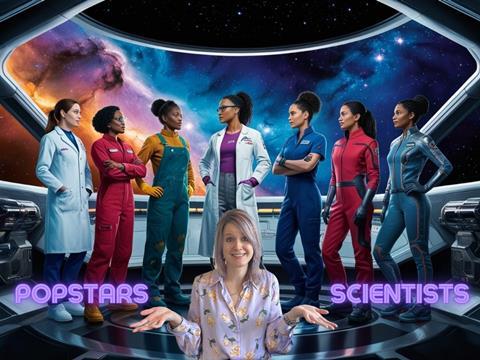
Despite high-profile initiatives to promote gender equality, women in science remain largely invisible – even when they reach space. In this column, Isabelle Kohler reflects on the recent all-female space flight and the media’s focus on celebrities over scientists. She explores how gender bias continues to shape scientific visibility and shares actionable steps researchers can take to foster a more inclusive and equitable academic culture.
You can’t have missed it: pop star Katy Perry has been to space! On 14 April, the Blue Origin crew made history, with the first all-female team in space since 1963. If you read the headlines, you probably saw that Perry was joined by journalist Lauren Sanchez (licensed pilot and entrepreneur, but also Jeff Bezos’ fiancée), television host Gayle King, and executive producer Kerianne Flynn. What was barely mentioned? That two actual scientists were also part of the mission: aerospace engineer Aisha Bowe and bioastronautics researcher Amanda Nguyen.
Even in moments meant to celebrate women, science gets sidelined. The media flooded us with images of Perry kissing the Earth, holding a daisy in her hands. But the work of the two scientists? Barely acknowledged. Would it have been the same with an all-male crew? To me, it felt like yet another reminder: women in science remain largely invisible – even when they’re quite literally reaching for the stars.
This isn’t new. Female scientists have been sidelined for decades. Yes, we now have designated days like the International Day of Women and Girls in Science or International Women’s Day – but visibility remains surface-level. And while you’d expect progress, recent developments have been alarming. In the U.S., policies that disadvantage women – whether as researchers or research subjects – are being approved. It’s like watching the clock turn backwards.
Closer to home, I’ve seen multiple conferences this past year with all-male speaker lineups. This, despite the huge number of brilliant female scientists around. As someone with many “privileges” (white, Swiss, financially literate, cis, heterosexual, and working in a relatively progressive country), you’d think this doesn’t affect me. It does – and always has. I’ve lost count of the times I’ve been condescended to by male colleagues, asked about my plans to have children, received comments on my outfit instead of my talk, been expected to take the minutes, or had men explain science or academia to me, assuming that because I look young, I must know less. All while I’ve been building a successful academic career and running my own company.
If this happens to someone like me, imagine the barriers for those with fewer privileges. If we’re not seen, we’re not heard. And if we’re not heard, we don’t get cited, funded, promoted – or remembered. Often, we have to work harder just to be given the same amount of space.
We keep saying we want to “inspire the next generation.” But how can young women dream of becoming scientists if they never see us – especially in leadership roles or in the media? How will a girl passionate about science feel, seeing that a pop star gets all the attention after a groundbreaking scientific mission?
It’s time to change this. And for that, I’m calling on all scientists – whatever their gender – to become more self-aware and to act. Every step counts. Let’s start small and let things compound.
- Shape the system from within. When organizing a conference or a panel, make diversity non-negotiable. In 2025, there’s no excuse for all-male speaker programs. And when you come across one? Say no (as a participant or a speaker) – explain why, and walk away.
- Take up space. If you belong to a minority group (women included), join boards, committees, and associations. Visibility isn’t just about being seen; it’s about shaping the conversation. It takes more time and effort, yes – but this is where real influence happens. If you’re a man, consider nominating your female colleagues for these roles.
- Be the role model you wish you had. Many women of my generation grew up without any. And we all know how powerful role models and mentors can be. Share your story. Mentor. Speak up. Show younger scientists what’s possible. Science communication doesn’t need fancy TV equipment and well-thought scripts: visibility can be as simple as telling your story on social media.
- Be unapologetically yourself. Wear what you want. Lead the way you want. Be loud or quiet or brilliant or tired – but be real. We shouldn’t have to shrink ourselves to fit into outdated molds. If you’re a man, support your colleagues – and keep your comments on their appearance to yourself.
- Call things out. When someone crosses a line, say it. Whether you’re the target or a witness. If a joke isn’t funny, name it. Even if it takes time to process, don’t let it go unexplained. If someone crosses your boundaries, report it. There’s always someone who will listen and act – be it a confidential advisor, a colleague, or a teacher. Boundaries matter. Silence protects the wrong people.
We can’t wait for visibility to be granted to us — we have to claim it. And we have to make room for others as we do. This isn’t just a women’s issue; it’s a collective mission. Everyone in science, whatever their gender, has a role to play in shaping a more inclusive and visible future. So, the next time the headlines are filled with celebrity dazzle and rocket launches, let’s not forget who’s doing the real heavy lifting behind the scenes. It’s time we all get a seat on the rocket.
If you are interested in learning more about how to navigate academia – whatever your gender, do not hesitate to join the NextMinds Community! For this, you have plenty of choices: visit NextMinds website to learn more about my work, sign up for the newsletter, and follow me and NextMinds on LinkedIn.

















Nog geen opmerkingen